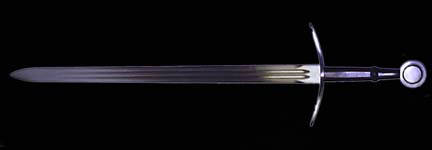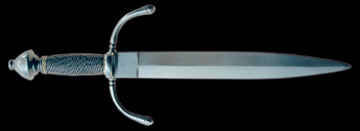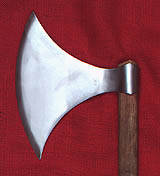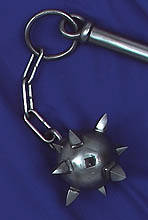
|

|

|

|

|

|

|

|

|

|

|

|

|

|

|

|

|

|

|

|

|

|

|

|
|
|

|
|
|
|
|

|
|
|
|
A deadly and sharp stilletto, some
times called a boudoir knife.
|
|
|
|
The scramasax is an all purpose knife of the
Northern World. Most recently sold at the
festival of Oleani as a skinning dagger.
|
|
|
|
|

|
|
|
The falchion-Though few examples of this workmanlike sword survive, from manuscript
illuminations and first-hand accounts, this large chopping sword was a popular choice among
knights.
|
During the 13th Century, the blade became wider at the optimal striking point. The
|
falchion appears to be a singularly English weapon and believed to be
|
derived from the long Norwegian "sax". Illustrations from the period seem to indicate the
|
falchion as a weapon most likely to be used on foot, perhpas because of its "chopping"
|
design and balance.
|
Within the game, it is usually one of the first weapons someone trained in OHE would get.
There are many different variations and adornments done to them as well.
|
|
|
|

|
|
|
Bastard sword-Usually referred to as a "bastard", as it is neither a single-handed nor a
true two-handed sword, these swords became quite popular during the late 1400's
|
|
|
|
|

|
|
|
|
An incised slab in the churchyard at Kinkell, Aberdeenshire is believed to be the monument
|
of Robert de Greenlaw, who died in 1411. On the slab, at the figure's right hip, hangs a
|
sword of very distinctive shape, with a wheel pommel and dramatically down-turned
|
quillons. This replica, made by Del Tin Antiche, Italy, is very similar to that sword, and
|
others found from that period. The same distinctive "claymore" downturned-quillons
|
would later become a hallmark of the famous two-handed swords of the Scots Highlanders.
|
A weapon often used in the game by warriors, known for its hard hitting attributes, often
killing in one swing.
|
|
|
|

|
|
|
|
This clean and functional early 16th Century two-hander is a copy of a sword from Sweden.
|
The arms of the crossguard are bent in opposite directions. The "scent-bottle stopper"
|
pommel is faceted. The long wood grip is wrapped with leather cord. The long chrome
|
vanadium steel blade is diamond in cross section.
|
|
|
|

|
|
|
|
This is a weapon that is classified as a dagger, yet shares many of the attributes of a sword.
|
Possibly part of a neo-Classical revival, this sword/dagger is more akin to the swords of
|
ancient Greece and the Bronze Age than to other contemporary Medieval swords.
|
Sometimes called the "Cinqueda" (because the blade was "five fingers" wide) or the
|
"Ox-tongue" dagger, these weapons came into style in Italy in the late 15th Century and
|
ceased being used by the early 16th century.
|
Sold at the Oleani festival as a skinning dagger most recently.
|
|
|
|

|
|
|
|
Main Gauche-Late Sixteenth Century. Diamond section blade, larger towards the point.
Steel quillons with arms arched downwards and ring to protect the hand. Steel pommel.
Wooden grip bound with twisted iron wire and intertwined brass rings.
|
|
|
|

|
|
|
|
|
Axes come in many different shapes and sizes and
have been used for many different purposes,
including battle, various purposes in survival and
chopping. They have been used in calvary battle
by both foot and horseback warriors.
|
|
|
|

|
|
|
|
|
Flail-The earliest flails were merely adaptations of agricultural
|
tools (grain threshers, for example) but served well as
|
weapons of war. Both cavalry and dismounted soldiers used
|
flails; the cavalry flails were generally smaller and lighter.
|
|
|
|
|
|
|
|
|
|
|
|
|
|
|
|
|
|
|
|
|
|
|

|
|